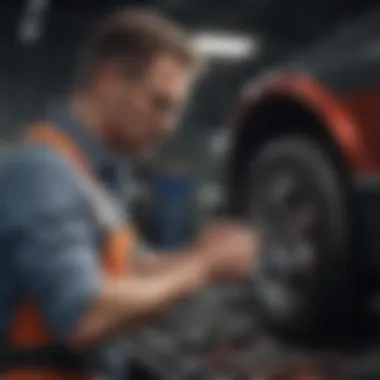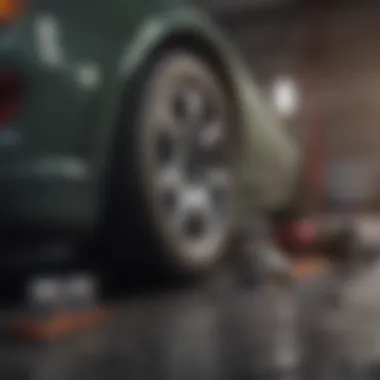Understanding the Importance of Multi-Point Inspections


Intro
A multi-point inspection serves as a critical element in maintaining vehicle health. This process meticulously reviews various components of the car, focusing on its overall condition and performance. Both visual assessments and practical tests are integral parts of this inspection, ensuring that potential issues do not escape attention. For automotive enthusiasts and everyday car owners, understanding the significance of such inspections can lead to better maintenance decisions and enhanced safety.
In depth exploration of multi-point inspections reveals its necessity not just for vehicle upkeep but also for ensuring longevity. Regular inspections can make a notable difference in a vehicle's reliability and performance, as well as save owners from costly repairs down the line. Let’s delve into key aspects of performance metrics related to these inspections.
Performance Metrics
The evaluation of performance metrics during a multi-point inspection is crucial. Elements like fuel efficiency and handling are vital indicators of how well a vehicle operates.
Fuel Efficiency
Fuel efficiency is an increasingly important metric in today’s automotive landscape. It not only impacts the owner's wallet but also influences environmental concerns. During a multi-point inspection, technicians measure various factors that can affect fuel economy. This includes air filter condition, tire pressure, and engine performance. For instance, a clogged air filter can significantly reduce fuel efficiency.
Handling and Stability
Another critical performance metric is a car's handling and stability. These factors are essential for driving safety. Inspectors often check the brakes, suspension system, and alignment. Proper handling ensures that a vehicle can navigate different terrains and conditions effectively. Drivers who ignore these aspects may face severe consequences. A well-documented inspection can help identify issues before they become significant problems.
"Regular vehicle inspections are not just about compliance; they are about safety and efficiency."
Car vs Boat Considerations
When perceiving inspections, comparisons between cars and boats also arise. Both have unique characteristics related to value retention and manufacturer reputation.
Value Retention and Depreciation
For vehicles, understanding value retention and depreciation is vital. A multi-point inspection can impact resale but does not replace a comprehensive documentation process. Thorough inspections might maintain a vehicle’s value over time. For boats, however, maintenance typically incurs a more considerable upfront cost attributed to their construction and materials. Hence, retaining value becomes a strategic consideration requiring thoughtful planning.
Manufacturer Reputation Analysis
Manufacturer reputation serves as another lens through which inspections can be analyzed. Brands with consistent quality and reliable performance often receive less scrutiny during inspections. Conversely, brands known for issues may require more rigorous inspections. This impacts not only the market perception but also the owner's sense of security.
Prologue to Multi-Point Inspections
Multi-point inspections serve an essential role in the realm of vehicle maintenance. They provide a systematic approach to evaluating a car's condition, ensuring that minor issues do not escalate into significant problems. This article will delve into the various facets of multi-point inspections, outlining their benefits, procedures, and relevance in maintaining vehicle safety and performance.
Definition and Purpose
A multi-point inspection is a comprehensive assessment of a vehicle's key components. It generally includes a thorough review of both the interior and exterior elements as well as diagnostic checks under the hood. The purpose is to identify existing issues and assess the overall health of the vehicle. Today’s vehicles are complex machines, and regular inspections can highlight problems that may not be visible to the naked eye. Identifying these issues early on can prevent costly repairs down the line, thus saving both time and money for vehicle owners.
Importance in Vehicle Maintenance
The importance of multi-point inspections in vehicle maintenance cannot be overstated. These inspections are not merely a recommendation but a necessity for preserving a car's longevity. Regular inspections
"In the automotive world, knowledge is power. A multi-point inspection can empower car owners to make informed decisions about their vehicles."
provide insights that facilitate proactive maintenance. They reveal not only current issues but also potential pitfalls related to engine, transmission, and brake systems. Moreover, comprehensive inspections can enhance safety on the road by ensuring that critical components are functioning properly. They also help car enthusiasts keep their vehicles in peak condition and care for their investment. As vehicles age, the likelihood of systemic issues increases. Therefore, the role of multi-point inspections expands because they adapt to the ongoing maintenance requirements through various life stages of a vehicle.
In summary, the knowledge gained from a multi-point inspection equips car owners, enthusiasts, and technicians alike to better understand the intricacies of vehicle reliability and safety. By committing to these inspections, one fosters a routine that not only enhances performance but also secures peace of mind.
Key Components of Multi-Point Inspections
Understanding the key components of multi-point inspections is crucial for any vehicle owner. These inspections serve as a comprehensive overview of the vehicle's overall health. Each component plays a specific role in maintaining the vehicle's performance and ensuring safety on the road. By examining exterior, interior, under the hood, and under the vehicle, car owners gain valuable insights into their vehicle’s condition. This section covers the essential parts of a multi-point inspection, outlining their importance and contribution to effective vehicle maintenance.
Exterior Components
Body Condition
Body condition is a primary focus in multi-point inspections. It assesses the car’s exterior for dents, scratches, and rust. Maintaining a good body condition is not just about aesthetics; it can prevent corrosion and other degradation caused by environmental factors. A clean and undamaged exterior can also retain higher resale value. Regular checks here can reveal issues early, before they escalate into major repair needs.
Lights and Signals


Lights and signals serve vital functions for safety. This includes headlights, taillights, turn signals, and brake lights. Properly functioning lights ensure visibility during night driving or bad weather, and signals are crucial for indicating turns and stops. Testing these lights as part of an inspection helps ensure they operate correctly, reducing the risk of accidents.
Tires
Tires significantly affect vehicle handling and safety. Inspecting tire tread depth, pressure, and condition helps ensure optimal performance. Worn-out tires can lead to poor grip and longer stopping distances. Timely checks can alert owners to the need for replacements, contributing to safer driving conditions.
Interior Components
Dashboard Lights
Dashboard lights provide important information about a vehicle's systems. They indicate the status of essential functions like oil pressure, engine temperature, and battery health. Monitoring these lights during inspection ensures that any warning signals are addressed promptly, which can prevent significant mechanical issues later on.
Seat Functionality
Seat functionality may seem minor, but it is critical for comfort and safety. Inspecting seat adjustments, belt functionality, and airbag readiness can assure that occupants remain secure during travel. Problems with seat functionality can contribute to an uncomfortable driving experience or severe safety risks in a collision.
Climate Control
A functioning climate control system is essential for driver comfort. Checking air conditioning and heating systems is important for ensuring a comfortable interior environment. If these components malfunction, it can lead to a frustrating driving experience, especially in extreme weather conditions.
Under the Hood Checks
Engine Condition
The engine is the heart of the vehicle, so assessing its condition is paramount. Inspectors often look for leaks, abnormal noises, and overall cleanliness. Timely detection of engine issues can result in significant cost savings and improved vehicle longevity.
Battery Status
The battery is crucial for vehicle operation. An inspection focuses on battery charge status, terminal corrosion, and physical condition. A well-functioning battery avoids unexpected breakdowns and ensures reliable starts.
Fluid Levels
Fluid levels, like oil, coolant, and transmission fluid, are vital for efficient vehicle function. Inspections check for leaks and assess fluid quality. Maintaining proper levels can prevent overheating, engine damage, and transmission issues.
Under Vehicle Inspection
Exhaust System
The exhaust system plays a key role in managing emissions. An inspection looks for leaks, rust, or damage. A properly functioning exhaust system minimizes harmful emissions, thus contributing to environmental health and vehicle efficiency.
Suspension Components
Suspension components directly affect ride quality and vehicle handling. During inspection, any wear or damage is noted, which could indicate the need for repairs. Proper suspension is essential for a smooth ride and vehicle stability.
Braking System
The braking system must be in top condition for safe driving. Inspectors examine brake pads, rotors, and fluid levels. Regular checks can identify issues before they lead to brake failure, ensuring safety on the road.
Regular multi-point inspections can enhance safety and vehicle longevity. They help owners stay informed of potential issues.
Procedure of a Multi-Point Inspection
The procedure of a multi-point inspection is critical for ensuring the longevity and safety of a vehicle. By following a systematic approach, technicians can accurately assess the condition of various components. This procedure helps identify potential problems before they escalate into significant issues. Consequently, regular inspections significantly contribute to the overall upkeep and performance of the vehicle.
Initial Vehicle Assessment
Before diving into the detailed inspection, a preliminary vehicle assessment must be conducted. This step helps technicians understand the vehicle's history and current issues. During this stage, technicians usually consider the following aspects:
- Vehicle Age: Older vehicles may need more attention due to wear and tear.
- Maintenance History: A review of past repairs can highlight recurring problems.
- Current Performance Issues: Any symptoms reported by the owner are documented for further evaluation.
This phase sets the groundwork for understanding what specific areas might require additional scrutiny during the inspection.


Step-by-Step Inspection Process
The thoroughness of the multi-point inspection comes from its step-by-step nature. Each component is examined methodically to ensure no detail is overlooked. The general steps include:
- Exterior Inspection: Inspect the body for dents, scratches, and rust. Check lights and signals for proper functionality. Tires are assessed for tread depth and overall condition.
- Interior Check: Ensure that dashboard warning lights are operational and investigate seat functionality and climate control systems.
- Under the Hood Assessment: Examine engine condition, battery status, and fluid levels. This includes checking oil, coolant, and brake fluids.
- Under Vehicle Inspection: Inspect critical systems underneath the vehicle, including the exhaust system, suspension components, and brakes.
Each step plays an essential role in offering a comprehensive understanding of the vehicle's condition. This type of procedure identifies minor issues before they require more substantial repairs.
Post-Inspection Review
After completing the inspection, a thorough post-inspection review is necessary. In this step, the technician will compile findings and recommend maintenance actions. Here are some crucial elements of this review:
- Summary of Findings: A detailed report outlining both minor and major issues discovered during the inspection.
- Recommendations: Suggested repairs or maintenance actions based on the findings. This may include urgent fixes or routine services.
- Owner Education: Explain the importance of addressing the found issues, helping vehicle owners understand how neglecting these could lead to more significant problems down the line.
"Regular multi-point inspections can save drivers from costly repairs and enhance vehicle safety."
The post-inspection review ensures that vehicle owners have a complete understanding of their car's state and the necessary steps required for effective maintenance. Following up on these recommendations is essential for preserving the vehicle's reliability and longevity.
Benefits of Multi-Point Inspections
The advantages of multi-point inspections are considerable. This thorough examination can significantly influence vehicle longevity and performance. Understanding these benefits equips car owners with essential knowledge for better maintenance. Below, we explore three primary benefits: enhanced safety, cost-effectiveness, and informed decision-making.
Enhanced Vehicle Safety
Vehicle safety should always be a priority for any driver. Multi-point inspections help uncover potential hazards before they become serious issues. For instance, the brakes, tires, and lights are crucial components for safe driving. A thorough inspection evaluates these areas carefully.
A 2020 study indicated that regular inspections reduce accident rates by identifying problems early. An inspection checks for issues with tire tread depth, lighting functionality, and brake responsiveness. When these elements are functioning optimally, drivers can feel more secure behind the wheel. Regular inspections contribute to a better understanding of vehicle performance as well.
"A multi-point inspection increases the likelihood of a safe driving experience."
Cost-Effective Maintenance
Cost is often a primary concern for vehicle owners. Multi-point inspections can actually help save money over time. Detecting issues early prevents minor concerns from snowballing into major repairs, which can lead to significant expenses. For example, noticing a minor oil leak during an inspection allows car owners to address it before further damage occurs.
Furthermore, identifying worn-out components can help prioritize repairs. Knowing what needs immediate attention versus what can wait allows for better budgeting. In the long run, investing in regular multi-point inspections often leads to lower overall maintenance costs. This aligns with best practices for vehicle upkeep, ensuring optimal performance without breaking the bank.
Informed Decision-Making for Car Owners
Informed decisions are key to maintaining a vehicle effectively. Multi-point inspections provide detailed reports on the current condition of a car, helping owners understand what repairs or maintenance are necessary. An inspection report offers insights into aspects such as fluid levels, tire conditions, and battery health.
Car owners can use this data to decide when to schedule repairs, which services to prioritize, and how to manage their vehicle more effectively. This reduces uncertainty and stress about vehicle upkeep. Additionally, it fosters a proactive approach to repairs and maintenance, promoting long-term vehicle health.
By incorporating the results from a multi-point inspection, owners can better strategize the timing of major expenses, such as replacements or extensive repairs. This informed decision-making creates a sense of control over vehicle maintenance, promoting a more satisfying ownership experience.
Frequency of Multi-Point Inspections
Understanding the frequency of multi-point inspections is important for maintaining the longevity and reliability of a vehicle. A multi-point inspection should not be viewed as a one-time event. Instead, it is a regular part of vehicle maintenance. By adhering to a recommended schedule, vehicle owners can catch minor issues before they evolve into major problems. This approach not only enhances the vehicle's performance but also prolongs its lifespan.
Recommended Inspection Schedule
The recommended inspection schedule usually suggests that car owners should have a multi-point inspection conducted at least once a year. However, this frequency can vary based on several factors, including the type of vehicle, driving conditions, and personal habits. Some manufacturers even recommend checks every 5,000 to 7,500 miles, often aligning with oil change intervals as a practical guideline.
Having inspections at regular intervals helps keep track of the vehicle’s overall health. It serves as a form of proactive maintenance, allowing for early detection of wear and tear.
Factors Affecting Inspection Frequency
Several factors influence how often a vehicle should undergo a multi-point inspection. Understanding these elements helps owners make an informed decision.
Driving Habits
Driving habits play a significant role in determining inspection frequency. For instance, someone who regularly drives in stop-and-go traffic will experience different wear on their vehicle compared to someone who mostly drives on highways. This can lead to premature wear on components like brakes and tires.


The key characteristic of driving habits is consistency. Frequent short trips can prevent the engine from reaching optimal operating temperatures, contributing to engine wear. Therefore, careful consideration of one’s driving patterns is essential in deciding how often to inspect the vehicle.
Age of Vehicle
The age of the vehicle also impacts inspection frequency. Older vehicles typically require more frequent inspections. As vehicles age, their components are more likely to show signs of wear. This means that what might have been a minor issue in a new vehicle could become serious in an older one.
A unique feature of aging vehicles is that they often have a history of previous repairs and modifications. Such past issues should be considered when determining how often to conduct inspections, especially for vintage models that require special care.
Environmental Conditions
Environmental conditions cannot be overlooked when discussing inspection frequency. Vehicles exposed to harsh weather, road salt, or rural conditions may require more frequent checks. More dust, sand, or grime can accumulate in parts that impact performance over time.
The key aspect of environmental conditions is the effect of elements such as humidity and temperature extremes. These can cause greater oxidation and corrosion. Moreover, regions prone to extreme weather may see vehicles experiencing different stress levels in components, thereby necessitating more frequent inspections than what might be standard in milder climates.
Ultimately, the overall approach to determining the frequency of multi-point inspections requires a balance between these considerations. Vehicle owners are encouraged to keep detailed records of their vehicle's inspection history and maintenance, ensuring a holistic view of their automotive needs.
Common Findings in Multi-Point Inspections
Multi-point inspections play a crucial role in vehicle maintenance by uncovering issues that might otherwise go unnoticed. Understanding common findings during these inspections is essential for car owners. These findings can be categorized into two types: minor issues and major repairs needed. Both have implications not only for the vehicle's performance but also for safety.
"Early detection of minor issues can prevent bigger problems down the road, saving time and money for vehicle owners."
Minor Issues
Minor issues discovered during a multi-point inspection often include basic maintenance needs and small repairs. These problems might seem insignificant at first glance, but addressing them promptly can enhance the vehicle's overall performance and longevity. Some typical minor issues found include:
- Tire Pressure Imbalance: It is common for tire pressure to vary, resulting in uneven wear and potential alignment problems.
- Worn Wiper Blades: Over time, wiper blades can become less effective due to wear, impacting visibility during rain.
- Dirty Air Filters: Clogged air filters can affect engine performance and fuel efficiency. Replacing them regularly is advisable.
- Low Fluid Levels: Brake fluid, coolant, and oil levels might drop, requiring a refill.
Addressing these minor issues, while seemingly trivial, helps in maintaining the vehicle and preventing escalated problems in the future. The costs associated with these repairs are often minimal compared to major repairs that could arise if they are neglected.
Major Repairs Needed
In contrast, major repairs indicate that a significant problem exists, necessitating more extensive intervention. These findings often involve critical vehicle systems and can pose serious safety risks. Common major repairs identified during inspections include:
- Engine Issues: Problems such as overheating or unusual noises can signify engine complications that require immediate attention.
- Suspension Repairs: Worn-out shocks or struts can affect vehicle handling and safety, making timely repair necessary.
- Brake System Failures: Discovering worn brake pads or damaged rotors is vital since braking capability directly relates to safety.
- Transmission Problems: Issues like slipping gears or fluid leaks often require professional assessment and can be costly to repair.
Major repairs should always be taken seriously, as they impact not just the car's performance but also the safety of everyone on the road. Ignoring these findings could lead to more severe damages and higher repair costs in the long term.
In summary, multi-point inspections serve as an early diagnostic tool for vehicle health. By paying attention to both minor issues and major repairs, car owners can make informed decisions about their vehicle maintenance needs, ultimately fostering a safer driving experience.
Choosing a Service Provider for Inspections
Selecting the right service provider for multi-point inspections is crucial for your vehicle's longevity and performance. Not every service center offers the same level of expertise or thoroughness. A trusted provider will not only perform the inspection effectively but also help you understand the findings and recommend necessary actions. Making an informed choice can prevent potential issues and unexpected repair costs down the line.
What to Look For
When considering a service provider, focus on key factors that can indicate quality and reliability:
- Reputation: Check online reviews and ratings. Websites like Reddit and Facebook can offer real feedback from past customers. A strong reputation usually corresponds to higher service standards.
- Experience: Look for service providers with extensive experience in the automotive field. Those who have been around longer often bring valuable insights and practical know-how to inspections.
- Services Offered: Beyond multi-point inspections, the provider should also offer additional services like repairs and maintenance. This can save time and provide convenience if issues are found during the inspection.
- Customer Service: Engage with the staff before committing. Good customer service can reflect the overall quality of the establishment. Staff should be willing to answer questions and explain processes clearly.
- Equipment and Technology: Ensure the service center uses up-to-date diagnostic tools and equipment. Modern technology can enhance the inspection's accuracy.
Certification and Training
Certification is another key aspect. Look for providers whose technicians have received formal training and accreditation. Certified professionals are more likely to stay updated on industry standards and practices. They often have a thorough understanding of vehicle systems, which aids in conducting the inspection with precision.
- ASE Certification: This standard shows that a technician has proven their knowledge and skill through testing. A service provider with ASE-certified staff demonstrates commitment to quality.
- Manufacturer Certification: Some service centers are certified by vehicle manufacturers. This indicates specialized training and familiarity with specific vehicles, which can enhance the inspection process.
- Continuing Education: In an ever-evolving automotive industry, continuous training is a sign of a provider dedicated to keeping pace with advancements.
Choosing the right service provider can have far-reaching effects on your vehicle's health. Take the time to research and ask the right questions. An informed decision can extend the lifespan of your car and ensure its safe operation.
Epilogue
The conclusion of this article serves to encapsulate the significance of multi-point inspections for vehicles and their essential role in maintaining automotive safety and performance. As outlined, the thorough examination provided by these inspections allows car owners to identify potential issues before they escalate into costly repairs. This proactive approach not only enhances the longevity of the vehicle but also promotes overall driving safety.
Summary of Importance
Multi-point inspections are invaluable in keeping vehicles in optimal condition. Regular checks can uncover a range of issues, from minor inconveniences to major problems, thereby informing vehicle owners about necessary repairs and maintenance. The comprehensive nature of these inspections addresses both performance and safety, making them a cornerstone of responsible vehicle ownership. Consistent engagement with this process fosters a deeper understanding of one’s vehicle, empowering owners to make informed decisions about their maintenance needs.
Final Thoughts on Vehicle Maintenance
Adopting a vigilant approach toward vehicle care enhances not only the driving experience but also supports environmental sustainability efforts by ensuring that vehicles operate efficiently. In an era where vehicle safety and efficiency are paramount, multi-point inspections emerge as a fundamental practice for all vehicle owners.



